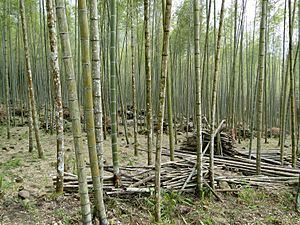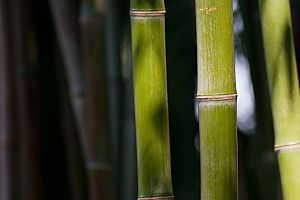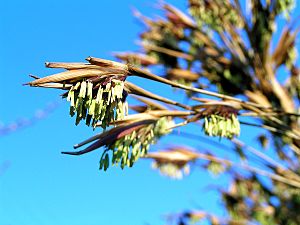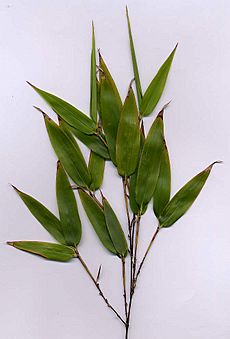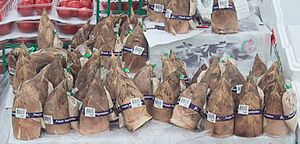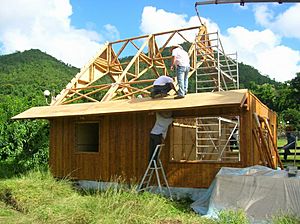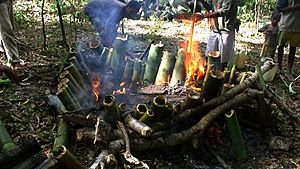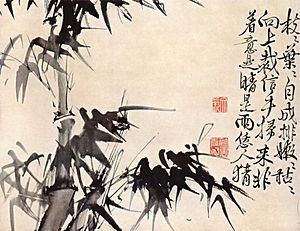Bamboo facts for kids
Quick facts for kids Bamboo |
|
|---|---|
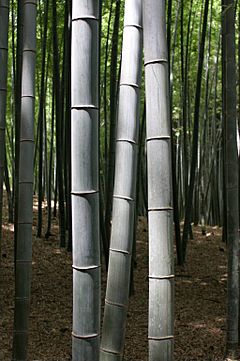 |
|
| Bamboo forest in Kyoto, Japan | |
| Scientific classification | |
| Kingdom: | |
| Division: | |
| Class: | |
| Order: | |
| Family: | |
| Subfamily: |
Bambusoideae
|
Bamboo is a name for over 1,400 species of giant grasses in 115 different genera. All bamboos have wood-like stems. Bamboo mainly grows in Africa, America and in Asia but can easily grow in Europe.
Bamboo grows in clumps (although running varieties exist). The runners can be up to 40 metres (130 feet). David Farrelly, in his book The Book of Bamboo, says that bamboo has been measured to grow 1.21 meter (47.6 inches) in a 24-hour period. However, most bamboos (used for gardening) will grow more like 3 cm to 5 cm (1-2 inches)a day.
Almost all species of bamboo have hollow stems divided into nodes or joints. The stem can be up to 30 cm (a foot) in diameter. Each of the node has one side bud. Not all of those buds develop into branches, but some do. This makes bamboo one of the few grasses that have a branch structure. Bamboo rarely flowers. Some species only flower once, and then die off. The distance of two joints in a bamboo is the basis of a traditional Japanese unit of measurement, shaku.
Contents
Ecology
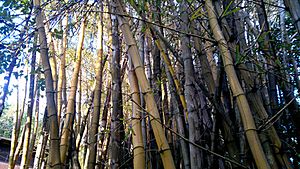
Bamboo is one of the fastest-growing plants on Earth, with reported growth rates of 100 cm (39 in) in 24 hours. However, the growth rate is dependent on local soil and climatic conditions, as well as species, and a more typical growth rate for many commonly cultivated bamboos in temperate climates is in the range of 3–10 centimetres (1.2–3.9 in)* per day during the growing period. Primarily growing in regions of warmer climates during the late Cretaceous period, vast fields existed in what is now Asia.
Bamboo is a kind of grass, which explains the speed of growth. This means that there's lots of it, and when it's harvested it grows itself back again quickly enough not to leave a dent in the eco-system. Unlike all trees, individual bamboo stems, or culms, emerge from the ground at their full diameter and grow to their full height in a single growing season of three to four months.
During these several months, each new shoot grows vertically into a culm with no branching out until the majority of the mature height is reached. Then, the branches extend from the nodes and leafing out occurs. In the next year, the pulpy wall of each culm slowly hardens. During the third year, the culm hardens further. The shoot is now considered a fully mature culm.
Many tropical bamboo species will die at or near freezing temperatures, while some of the hardier or so-called temperate bamboos can survive temperatures as low as −29 °C (−20 °F). Some of the hardiest bamboo species can be grown in places as cold as USDA Plant Hardiness Zones 5–6, although they typically will defoliate and may even lose all above-ground growth, yet the rhizomes will survive and send up shoots again the next spring. In milder climates, such as USDA Zone 8 and above, some hardy bamboo may remain fully leafed out year around.
Mass flowering
Most bamboo species flower infrequently. In fact, many bamboos only flower at intervals as long as 65 or 120 years. These taxa exhibit mass flowering (or gregarious flowering), with all plants in a particular species flowering worldwide over a several-year period. The longest mass flowering interval known is 130 years, and is found for all the species Phyllostachys bambusoides. In this species, all plants of the same stock flower at the same time, regardless of differences in geographic locations or climatic conditions, and then the bamboo dies.
The mass fruiting also has direct economic and ecological consequences, however. The huge increase in available fruit in the forests often causes a boom in rodent populations, leading to increases in disease and famine in nearby human populations.
In any case, flowering produces masses of seeds, typically suspended from the ends of the branches. These seeds will give rise to a new generation of plants that may be identical in appearance to those that preceded the flowering, or they may also produce new cultivars with different characteristics, such as the presence or absence of striping or other changes in coloration of the culms.
As animal diet

Soft bamboo shoots, stems, and leaves are the major food source of the giant panda of China, the red panda of Nepal and the bamboo lemurs of Madagascar. Rats will eat the fruits as described above. Mountain gorillas of Africa also feed on bamboo, and have been documented consuming bamboo sap which was fermented and alcoholic; chimps and elephants of the region also eat the stalks.
The larvae of the bamboo borer (the moth Omphisa fuscidentalis) of Laos, Myanmar, Thailand and Yunnan Province, China, feeds off the pulp of live bamboo. In turn, these caterpillars are considered a local delicacy.
Cultivation
Commercial timber
Timber is harvested from cultivated and wild stands and some of the larger bamboos, particularly species in the genus Phyllostachys, are known as "timber bamboos".
Harvesting
Bamboo used for construction purposes must be harvested when the culms reach their greatest strength and when sugar levels in the sap are at their lowest, as high sugar content increases the ease and rate of pest infestation.
Harvesting of bamboo is typically undertaken according to the following cycles:
1) Life cycle of the culm: As each individual culm goes through a 5– to 7-year life cycle, culms are ideally allowed to reach this level of maturity prior to full capacity harvesting. The clearing out or thinning of culms, particularly older decaying culms, helps to ensure adequate light and resources for new growth. Well-maintained clumps may have a productivity three to four times that of an unharvested wild clump.
2) Life cycle of the culm: Consistent with the life cycle described above, bamboo is harvested from two to three years through to five to seven years, depending on the species.
3) Annual cycle: As all growth of new bamboo occurs during the wet season, disturbing the clump during this phase will potentially damage the upcoming crop. Also during this high rainfall period, sap levels are at their highest, and then diminish towards the dry season. Picking immediately prior to the wet/growth season may also damage new shoots. Hence, harvesting is best at the end of the dry season, a few months prior to the start of the wet.
4) Daily cycle: During the height of the day, photosynthesis is at its peak, producing the highest levels of sugar in sap, making this the least ideal time of day to harvest. Many traditional practitioners believe the best time to harvest is at dawn or dusk on a waning moon.
Leaching
Leaching is the removal of sap after harvest. In many areas of the world, the sap levels in harvested bamboo are reduced either through leaching or postharvest photosynthesis. Examples of this practice include:
- Cut bamboo is raised clear of the ground and leant against the rest of the clump for one to two weeks until leaves turn yellow to allow full consumption of sugars by the plant.
- A similar method is undertaken, but with the base of the culm standing in fresh water, either in a large drum or stream to leach out sap.
- Cut culms are immersed in a running stream and weighted down for three to four weeks.
- Water is pumped through the freshly cut culms, forcing out the sap (this method is often used in conjunction with the injection of some form of treatment).
In the process of water leaching, the bamboo is dried slowly and evenly in the shade to avoid cracking in the outer skin of the bamboo, thereby reducing opportunities for pest infestation.
Durability of bamboo in construction is directly related to how well it is handled from the moment of planting through harvesting, transportation, storage, design, construction and maintenance. Bamboo harvested at the correct time of year and then exposed to ground contact or rain, will break down just as quickly as incorrectly harvested material.
Ornamental bamboos
The two general patterns for the growth of bamboo are "clumping" (sympodial) and "running" (monopodial). Clumping bamboo species tend to spread slowly, as the growth pattern of the rhizomes is to simply expand the root mass gradually, similar to ornamental grasses. "Running" bamboos, on the other hand, need to be taken care of in cultivation because of their potential for aggressive behavior. They spread mainly through their roots and/or rhizomes, which can spread widely underground and send up new culms to break through the surface. Running bamboo species are highly variable in their tendency to spread; this is related to both the species and the soil and climate conditions. Some can send out runners of several metres a year, while others can stay in the same general area for long periods. If neglected, over time they can cause problems by moving into adjacent areas.
Bamboos seldom and unpredictably flower, and the frequency of flowering varies greatly from species to species. Once flowering takes place, a plant will decline and often die entirely. Although there are always a few species of bamboo in flower at any given time, collectors desiring to grow specific bamboo typically obtain their plants as divisions of already-growing plants, rather than waiting for seeds to be produced.
Uses
Culinary
The empty hollow in the stalks of larger bamboo is often used to cook food in many Asian cultures. Soups are boiled and rice is cooked in the hollows of fresh stalks of bamboo directly over a flame. Similarly, steamed tea is sometimes rammed into bamboo hollows to produce compressed forms of Pu-erh tea. Cooking food in bamboo is said to give the food a subtle but distinctive taste.
In addition, bamboo is frequently used for cooking utensils within many cultures, and is used in the manufacture of chopsticks. In modern times, some see bamboo tools as an ecofriendly alternative to other manufactured utensils.
Medicine
Bamboo is used in Chinese medicine for treating infections and healing.
Construction

Bamboo, like true wood, is a natural composite material with high strength-to-weight ratio useful for structures.
In its natural form, bamboo as a construction material is traditionally associated with the cultures of South Asia, East Asia and the South Pacific, to some extent in Central and South America, and by extension in the aesthetic of Tiki culture. In China and India, bamboo was used to hold up simple suspension bridges, either by making cables of split bamboo or twisting whole culms of sufficiently pliable bamboo together. One such bridge in the area of Qian-Xian is referenced in writings dating back 960 AD, and may have stood since as far back as the third century BC, due largely to continuous maintenance.
Bamboo has also long been used as scaffolding; the practice has been banned in China for buildings over six storeys, but is still in continuous use for skyscrapers in Hong Kong. In the Philippines, the nipa hut is a fairly typical example of the most basic sort of housing where bamboo is used; the walls are split and woven bamboo, and bamboo slats and poles may be used as its support. In Japanese architecture, bamboo is used primarily as a supplemental and/or decorative element in buildings such as fencing, fountains, grates and gutters, largely due to the ready abundance of quality timber.
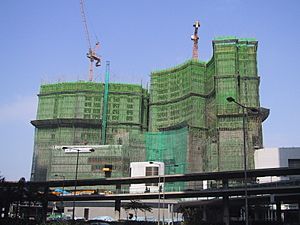
Various structural shapes may be made by training the bamboo to assume them as it grows. Squared sections of bamboo are created by compressing the growing stalk within a square form. Arches may similarly be created by forcing the bamboo's growth with the desired form, and costs much less than it would to assume the same shape in regular wood timber. More traditional forming methods, such as the application of heat and pressure, may also be used to curve or flatten the cut stalks.
Bamboo can be cut and laminated into sheets and planks. This process involves cutting stalks into thin strips, planing them flat, boiling and drying the strips; they are then glued, pressed and finished. Generally long used in China and Japan, entrepreneurs started developing and selling laminated bamboo flooring in the West during the mid-1990s; products made from bamboo laminate, including flooring, cabinetry, furniture and even decorations, are currently surging in popularity, transitioning from the boutique market to mainstream providers, such as Home Depot. The bamboo goods industry (which also includes small goods, fabric, etc.) is expected to be worth $25 billion by 2012. The quality of bamboo laminate varies between manufacturers and the maturity of the plant from which it was harvested (six years being considered the optimum); the sturdiest products fulfil their claims of being up to three times harder than oak hardwood, but others may be softer than standard hardwood.
Bamboo intended for use in construction should be treated to resist insects and rot. The most common solution for this purpose is a mixture of borax and boric acid. Another process involves boiling cut bamboo to remove the starches that attract insects.
Bamboo has been used as reinforcement for concrete in those areas where it is plentiful, though dispute exists over its effectiveness in the various studies done on the subject. Bamboo does have the necessary strength to fulfil this function, but untreated bamboo will swell from the absorption of water from the concrete, causing it to crack. Several procedures must be followed to overcome this shortcoming.
Several institutes, businesses, and universities are researching the use of bamboo as an ecological construction material. In the United States and France, it is possible to get houses made entirely of bamboo, which are earthquake and cyclone-resistant and internationally certified. In Bali, Indonesia, an international k-12 school, the Green School, is constructed entirely of bamboo, for its beauty and advantages as a sustainable resource. There are three ISO standards for bamboo as a construction material.
Textiles
Since the fibers of bamboo are very short (less than 3 mm), they are impossible to transform into yarn in a natural process. The usual process by which textiles labeled as being made of bamboo are produced uses only rayon made from the fibers with heavy employment of chemicals. To accomplish this, the fibers are broken down with chemicals and extruded through mechanical spinnerets; the chemicals include lye, carbon disulfide and strong acids. Retailers have sold both end products as "bamboo fabric" to cash in on bamboo's current ecofriendly cachet; however, the Canadian Competition Bureau and the US Federal Trade Commission, as of mid-2009, are cracking down on the practice of labeling bamboo rayon as natural bamboo fabric. Under the guidelines of both agencies, these products must be labeled as rayon with the optional qualifier "from bamboo".
Paper
Bamboo fiber has been used to make paper in China since early times. A high-quality, handmade paper is still produced in small quantities. Coarse bamboo paper is still used to make spirit money in many Chinese communities.
Bamboo pulps are mainly produced in China, Myanmar, Thailand and India, and are used in printing and writing papers. The most common bamboo species used for paper are Dendrocalamus asper and Bamboo bluemanea. It is also possible to make dissolving pulp from bamboo. The average fiber length is similar to hardwoods, but the properties of bamboo pulp are closer to softwood pulps due to it having a very broad fiber length distribution. With the help of molecular tools, it is now possible to distinguish the superior fiber-yielding species/varieties even at juvenile stages of their growth, which can help in unadulterated merchandise production.
Other uses
Bamboo has a long history of use in Asian furniture. Chinese bamboo furniture is a distinct style based on a millennia-long tradition.
Several manufacturers offer bamboo bicycles and skateboards.
Due to its flexibility, bamboo is also used to make fishing rods. The split cane rod is especially prized for fly fishing. Bamboo has been traditionally used in Malaysia as a firecracker called a meriam buluh or bamboo cannon. Four-foot-long sections of bamboo are cut, and a mixture of water and calcium carbide are introduced. The resulting acetylene gas is ignited with a stick, producing a loud bang. Bamboo can be used in water desalination. A bamboo filter is used to remove the salt from seawater.
Food is cooked in East Timor in bamboo in fire. This is called Tukir.
In Asian culture
Bamboo's long life makes it a Chinese symbol of longevity, while in India it is a symbol of friendship. The rarity of its blossoming has led to the flowers' being regarded as a sign of impending famine. This may be due to rats feeding upon the profusion of flowers, then multiplying and destroying a large part of the local food supply. The most recent flowering began in May 2006 (see Mautam). Bamboo is said to bloom in this manner only about every 50 years (see 28–60 year examples in FAO: 'gregarious' species table).
In Chinese culture, the bamboo, plum blossom, orchid, and chrysanthemum (often known as méi lán zhú jú 梅兰竹菊) are collectively referred to as the Four Gentlemen. These four plants also represent the four seasons and, in Confucian ideology, four aspects of the junzi ("prince" or "noble one"). The pine (sōng 松), the bamboo (zhú 竹), and the plum blossom (méi 梅) are also admired for their perseverance under harsh conditions, and are together known as the "Three Friends of Winter" (岁寒三友 suìhán sānyǒu) in Chinese culture. The "Three Friends of Winter" is traditionally used as a system of ranking in Japan, for example in sushi sets or accommodations at a traditional ryokan. Pine (matsu 松) is of the first rank, bamboo (také 竹) is of second rank, and plum (ume 梅) is of the third.
In mythology
Several Asian cultures, including that of the Andaman Islands, believe humanity emerged from a bamboo stem.
In Philippine mythology, one of the more famous creation accounts tells of the first man, Malakás ("Strong"), and the first woman, Maganda ("Beautiful"), each emerged from one half of a split bamboo stem on an island formed after the battle between Sky and Ocean. In Malaysia, a similar story includes a man who dreams of a beautiful woman while sleeping under a bamboo plant; he wakes up and breaks the bamboo stem, discovering the woman inside. The Japanese folktale "Tale of the Bamboo Cutter" (Taketori Monogatari) tells of a princess from the Moon emerging from a shining bamboo section. Hawaiian bamboo ('ohe) is a kinolau or body form of the Polynesian creator god Kāne.
A bamboo cane is also the weapon of Vietnamese legendary hero, Saint Giong, who had grown up immediately and magically since the age of three because of his wish to liberate his land from Ân invaders. An ancient Vietnamese legend (The Hundred-knot Bamboo Tree) tells of a poor, young farmer who fell in love with his landlord's beautiful daughter. The farmer asked the landlord for his daughter's hand in marriage, but the proud landlord would not allow her to be bound in marriage to a poor farmer. The landlord decided to foil the marriage with an impossible deal; the farmer must bring him a "bamboo tree of 100 nodes". But Buddha (Bụt) appeared to the farmer and told him that such a tree could be made from 100 nodes from several different trees. Bụt gave to him four magic words to attach the many nodes of bamboo: Khắc nhập, khắc xuất, which means "joined together immediately, fell apart immediately". The triumphant farmer returned to the landlord and demanded his daughter. Curious to see such a long bamboo, the landlord was magically joined to the bamboo when he touched it, as the young farmer said the first two magic words. The story ends with the happy marriage of the farmer and the landlord's daughter after the landlord agreed to the marriage and asked to be separated from the bamboo.
In a Chinese legend, the Emperor Yao gave two of his daughters to the future Emperor Shun as a test for his potential to rule . Shun passed the test of being able to run his household with the two emperor's daughters as wives, and thus Yao made Shun his successor, bypassing his unworthy son. Later, Shun drowned in the Xiang River. The tears his two bereaved wives let fall upon the bamboos growing there explains the origin of spotted bamboo. The two women later became goddesses.
As a writing surface
Bamboo was in widespread use in early China as a medium for written documents. The earliest surviving examples of such documents, written in ink on string-bound bundles of bamboo strips (or "slips"), date from the fifth century BC during the Warring States period. However, references in earlier texts surviving on other media make it clear that some precursor of these Warring States period bamboo slips was in use as early as the late Shang period (from about 1250 BC).
Bamboo or wooden strips were the standard writing material during the Han dynasty, and excavated examples have been found in abundance. Subsequently, paper began to displace bamboo and wooden strips from mainstream uses, and by the fourth century AD, bamboo slips had been largely abandoned as a medium for writing in China. Several paper industries are surviving on bamboo forests. Ballarpur (Chandrapur, Maharstra) paper mills use bamboo for paper production.
As a weapon
Bamboo is used in several East Asian and South Asian martial arts.
- In the ancient Tamil martial art of Silambam, fighters would hit each other rapidly with bamboo sticks.
- In the Japanese martial art Kendo, bamboo is used to make the Shinai sword.
- Bamboo is used for crafting the world's longest bows, the Yumi, and the arrows used in the Japanese martial art Kyudo.
- In traditional archery, the longbow and recurve bow limbs are sometimes crafted with flat ground bamboo, and also used to make superior weapons for bowhunting and target archery.
- A bamboo stick can be made into a simple spear by sharpening one of the ends.
- History's first gunpowder-based weapons, such as the fire lance, were made of bamboo.
Other cultures
The ethnic group, the Bozo of West Africa, take their name from the Bambara phrase bo-so, which means "bamboo house".
Bamboo is the national plant of St. Lucia.
Images for kids
-
Woman gathering bamboo shoots, woodblock print by Suzuki Harunobu, 1765
-
Khao lam (Thai: ข้าวหลาม) is glutinous rice with sugar and coconut cream cooked in specially prepared bamboo sections of different diameters and lengths
-
Bamboo is extensively used for fishing and aquaculture applications on the Dayu Bay in Cangnan County, Zhejiang
-
A cylindrical bamboo brush holder or holder of poems on scrolls, created by Zhang Xihuang in the 17th century, late Ming or early Qing Dynasty – in the calligraphy of Zhang's style, the poem Returning to My Farm in the Field by the fourth-century poet Tao Yuanming is incised on the holder.
-
Kadomatsu made of bamboo for Japanese New Year
-
Მოსო ბამბუკი.JPG
Phyllostachys pubescens in Batumi Botanical Garden
-
Bamboo forest in Isère, France
-
Bamboo forest at the Rutgers Gardens, North Brunswick, New Jersey
See also
 In Spanish: Bambú para niños
In Spanish: Bambú para niños


